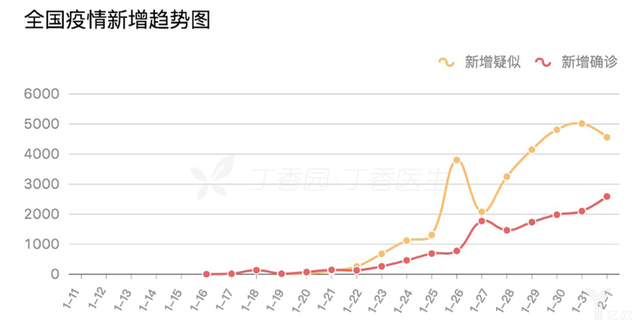 CN
CN info@seacomould.com
info@seacomould.com +86-18969612882
+86-18969612882
Coronavirus China Wuhan
As of February 2, 2020, according to real-time data from Lilac Garden, there were 14,418 confirmed cases of new coronavirus pneumonia, 19,544 suspected cases, 304 deaths, and 331 cures.
National defense control has achieved certain results. From January 31, the number of new suspected cases has begun to decline. On February 1, the number of new suspected cases has fallen to less than 5,000.

In the article "Thousands of Treasures, Exhausting the Yellow Sand, China's Intelligent Manufacturing Whistle | Foresee 2020", we summarized the fundamentals of China's manufacturing industry at the end of 2019. Under the influence of the declining macroeconomic growth rate), China's manufacturing industry has shown strong resilience, and overall stability has picked up.
However, the new crown epidemic brought the first super black swan in 2020. Due to postponed resumption of work, reduced demand, and PHEIC certification, the epidemic will inevitably have a certain impact on China's manufacturing economy.
On the one hand, the manufacturing industry itself will cause short-term production lag due to delays in resumption of work and deceleration in circulation; on the other hand, the impact from the fields of consumption, services, import and export will also spread to the manufacturing industry, which will reflect the manufacturing order volume Reduction of inventory.
With reference to the performance of the SARS period, the impact of the epidemic on the economy is limited, transient, and one-time. Compared to the impact of the economic cycle, the impact of the epidemic on the manufacturing industry is smaller, but compared to the impact of the SARS period on the economy The impact is greater.
What changed in China's manufacturing industry during the relatively SARS period?
Compared with the SARS period in 2003, China's manufacturing industry is no longer the same.
First, China ’s core industry has shifted from the secondary industry, which is dominated by manufacturing, to the tertiary industry. The transmission mechanism of the epidemic to the manufacturing industry may change. Second, the current cycle and international environment in which China is in With the earth-shaking changes, the general environment facing the manufacturing industry has changed. Finally, the current level of automation in China's manufacturing industry has also been greatly improved compared to 2003, and its ability to resist and repair will be greatly improved.
1. The secondary industry is no longer the strongest domestic force, and the indirect impact of the epidemic may be greater
China's tertiary industry accounted for 53.9% in 2019, exceeding 39.0% of the secondary industry; in 2003, the secondary industry accounted for the highest proportion, 45.6%.
The most direct impact of the general epidemic situation is the tertiary service industry, which is mainly catering, tourism, transportation, and retail. The direct impact on the manufacturing industry is mainly reflected in the inadequate supply of labor, raw materials, etc., and the impact transmitted by the tertiary industry reflects In terms of demand, order quantity, production mode, etc.
With the tertiary industry becoming the mainstay of China's economy, the indirect impact of this epidemic on manufacturing has been stronger than during the SARS period.
Related Products
Latest Updated
- China automotive mold manufacturing is facing the development trend of 2025
- The major development trend of automotive mould technology
- How to find a good automotive mould supplier and manufacturer in China
- How to make the injection plastic mould gate design
- The most likely defects in the mold injection molding process
- Injection mold repair steps and precautions
- Auto mould making-automould injection moulding company
- How to choose plastic mould supplier in Taizhou China
Relative Articles
- What profound impact will the new coronavirus have on Chinese manufacturing?
- How the impact of the new coronavirus on the shipping industry
- Ministry of Commerce Helps Foreign Trade Enterprises to Fight the coronavirus Epidemic
- Coronavirus:Impact of New Crown Epidemic on Manufacturing Industry and Analysis of Market Opportunities
- What impact will the coronavirus epidemic have on all industry
- World Health Organization is coordinating global gap in anti coronavirus equipment
- Taizhou mould factory when can come back to work after coronavirus
- When Huangyan Mold factory come back to work after coronavirus
- does taizhou mould factory come back to work during coronavirus
Hot Articles
- Mold plating chrome treatment technology is good for mold life
- Analysis of the causes of the fusion line of plastic mold products and corresponding improvement measures
- what are the common problem in the plastic mould injection process
- Leak-proof design of bottle cap mould
- What performance requirements should be met when selecting steel for injection mold
- When Huangyan Mold factory come back to work after coronavirus
- Coronavirus China Wuhan
- How to check the test of the injection mould
- How to choose plastic mould supplier in Taizhou China
- What principles should be followed in the design and development of bumpers mould
- Bottle cap mold manufacturing process
- Six standards for testing the quality of antifreeze bucket mould






